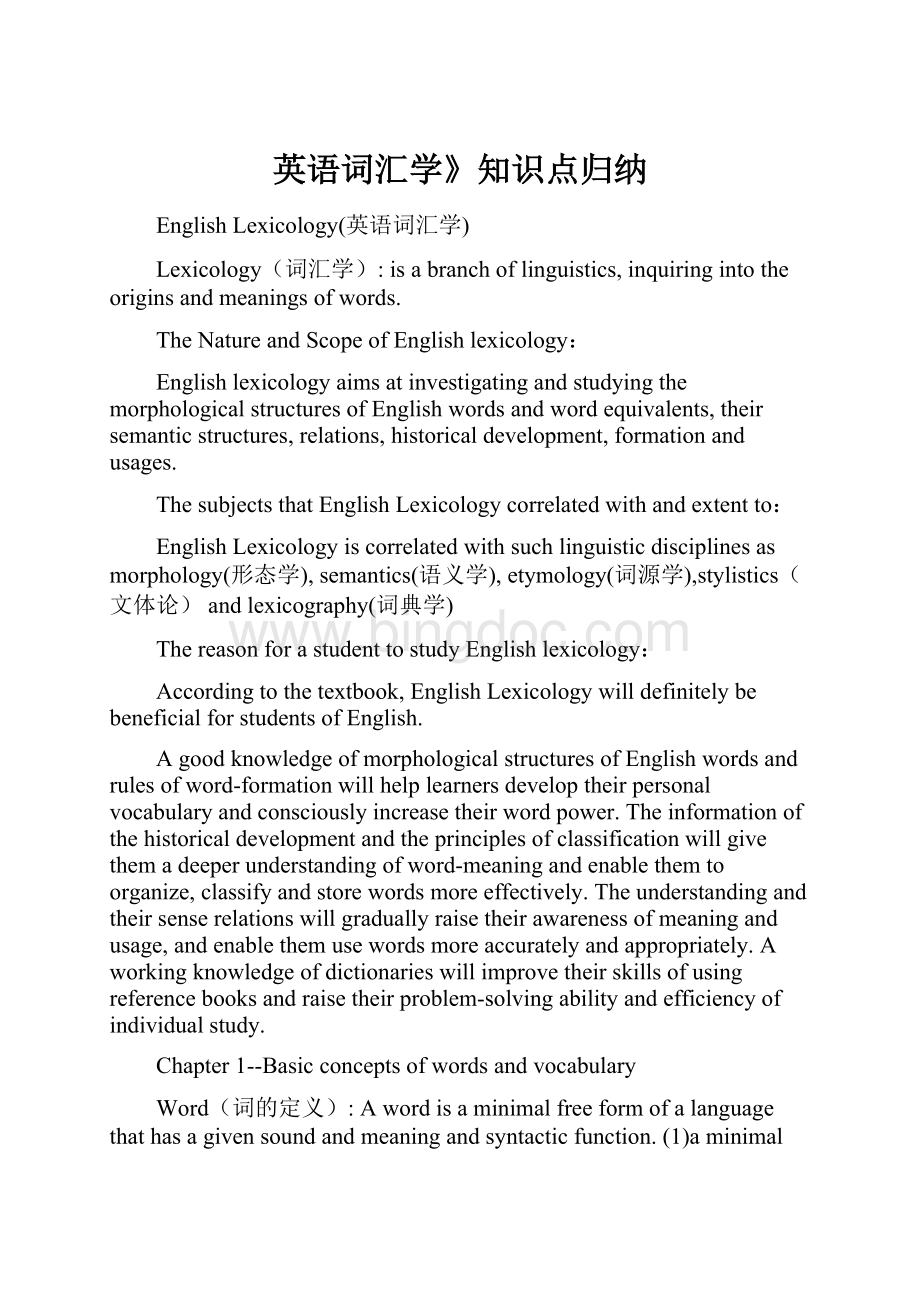英语词汇学》知识点归纳.docx
《英语词汇学》知识点归纳.docx》由会员分享,可在线阅读,更多相关《英语词汇学》知识点归纳.docx(21页珍藏版)》请在冰点文库上搜索。

英语词汇学》知识点归纳
EnglishLexicology(英语词汇学)
Lexicology(词汇学):
isabranchoflinguistics,inquiringintotheoriginsandmeaningsofwords.
TheNatureandScopeofEnglishlexicology:
EnglishlexicologyaimsatinvestigatingandstudyingthemorphologicalstructuresofEnglishwordsandwordequivalents,theirsemanticstructures,relations,historicaldevelopment,formationandusages.
ThesubjectsthatEnglishLexicologycorrelatedwithandextentto:
EnglishLexicologyiscorrelatedwithsuchlinguisticdisciplinesasmorphology(形态学),semantics(语义学),etymology(词源学),stylistics(文体论)andlexicography(词典学)
ThereasonforastudenttostudyEnglishlexicology:
Accordingtothetextbook,EnglishLexicologywilldefinitelybebeneficialforstudentsofEnglish.
AgoodknowledgeofmorphologicalstructuresofEnglishwordsandrulesofword-formationwillhelplearnersdeveloptheirpersonalvocabularyandconsciouslyincreasetheirwordpower.Theinformationofthehistoricaldevelopmentandtheprinciplesofclassificationwillgivethemadeeperunderstandingofword-meaningandenablethemtoorganize,classifyandstorewordsmoreeffectively.Theunderstandingandtheirsenserelationswillgraduallyraisetheirawarenessofmeaningandusage,andenablethemusewordsmoreaccuratelyandappropriately.Aworkingknowledgeofdictionarieswillimprovetheirskillsofusingreferencebooksandraisetheirproblem-solvingabilityandefficiencyofindividualstudy.
Chapter1--Basicconceptsofwordsandvocabulary
Word(词的定义):
Awordisaminimalfreeformofalanguagethathasagivensoundandmeaningandsyntacticfunction.
(1)aminimalfreeformofalanguage
(2)asoundunity(3)aunitofmeaning(4)aformthatcanfunctionaloneinasentence
Soundandmeaning(声音与意义):
almostarbitrary,“nologicalrelationshipbetweenthesoundwhichstandsforathingoranideaandtheactualthingandideaitself”
Soundandform(读音和形式):
不统一的四个原因
(1)theEnglishalphabetwasadoptedfromtheRomans,whichdoesnothaveaseparatelettertorepresenteachother
(2)thepronunciationhaschangedmorerapidlythanspellingovertheyears(3)someofthedifferencewerecreatesbytheearlyscribes(4)theborrowingsisanimportantchannelofenrichingtheEnglishvocabulary
Vocabulary(词汇):
allthewordsinalanguagemakeupitsvocabulary
ClassificationofEnglishWords:
Byusefrequency:
basicwordstock&nonbasicvocabulary
Bynotion:
contentwords&functionalwords
Byorigin:
nativewords&borrowedwords
Thebasicwordstock(基本词汇):
isthefoundationofthevocabularyaccumulatedovercenturiesandformsthecommoncoreofthelanguage.ThoughitconstituteasmallpercentageoftheEV,itisthemostimportantpartofvocabulary.
TheFundamentalFeaturesoftheBasicWordStock(基本词汇的特征):
1)All-Nationalcharacter(全民通用性mostimportant)2)Stability(相对稳定性)
3)Productivity(多产性)4)Polysemy(多义性)5)Collocability(可搭配性)
没有上述特征的words:
(1)Terminology(术语)
(2)Jargon(行话)(3)slang(俚语)(4)Argot(暗语)(5)Dialectalwords(方言)(6)Archaisms(古语)(7)Neologisms(新词语):
Neologismsmeansnewly-createdwordsorexpressions,orwordsthathavetakenonnewmeanings.(email)
Contentwords/notionalwords实词(cloud,runwalk,never,five,frequently)andfunctionalwords/emptywords虚词(on,of,and,be,but)
NativeWordsandBorrowedWords
Nativewords(本族语词):
knownasAnglo-Saxonwords(50,000-60,000),arewordsbroughttoBritaininthe5thcenturybytheGermanictribes.(mainstreamofthebasicword-stocks).Twootherfeatures:
(1)neutralinstyle
(2)frequentinuse
Borrowedwords/Loanwords(外来语词):
wordstakenoverfromforeignlanguages.(80%ofmodernEV)
4Typesofloanwords:
1)denizens(同化词):
(shirtfromskyrta(ON))
2)aliens(非同化词/外来词):
areborrowedwordswhichhaveretainedtheiroriginalpronunciationandspelling(kowtow(CH)磕头)
3)translationloans(译借词):
按其他语言方式组成英语longtimenosee(fromChina)
4)semanticloans(借义词):
theyarenotborrowedwithreferencetotheform,buttheirmeaningsareborrowed
Chapter2thedevelopmentoftheEnglishVocabulary
TheIndo-EuropeanLanguageFamily(印欧语系)
TheEightGroupsinIndo-EuropeanFamilyofLanguages(8大印欧语群)
TheEasternset:
(1)TheBalto-slavicGroup(波罗的-斯拉夫语族):
Russian,Bulgarian,Polish,Czechetc.
(2)TheIndo-IranianGroup(印度-伊朗语族):
Hindi,Bengali,Persianetc.
(3)TheArmenianGroup(亚美尼亚语族):
Armenian.
(4)TheAlbanianGroup(阿尔巴尼亚语族):
Albanian.
TheWesternset:
(5)TheHellenicGroup(古希腊语族):
Greek.
(6)TheItalianGroup(意大利语族):
Latin,Romancelanguages(French,Italian,Spanish,portuguese,Romanian)etc.
(7)TheCelticGroup(凯尔特语族):
Irish,Welsh,Bretonetc.
(8)TheGermanicGroup(日耳曼语族):
Flemish,German,Dutch,Scandinavian(Norweigian,Swedish,Danish,Icelandic)etc.
TheThreeStagesofDevelopmentoftheEnglishVocabulary:
1OldEnglish(450-1100)(vocabulary50,000to60,000):
wasIhighinflectedlanguage.
2MiddleEnglish(1150-1500):
retainesmuchfewerinflections
3ModernEnglish(1500-uptonow):
infactmorethan25%ofmodernEwordscomealmostdirectlyfromclassicallanguages.InModernE,wordsendingsweremostlylostwithjustafewexpections.Englishhasevolvedfromasyntheticlanguage(OldEnglish)tothepresentanalyticlanguage.
ModesofVocabularyDevelopment(词汇的发展模式):
1)creation创造新词:
theformationofnewwordsbyusingtheexistingmaterials,namelytoots,affixesandotherelements.(最重要方式)
2)semanticchange旧词新义:
doesnotincreasethenumberofwordformsbutcreatemanymorenewuseagesofthewords.
3)borrowing借用外来词:
constitutemerely6to7percentofallnewwords
RevivingwordsorobsoletewordsalsocontributestothegrowthofEnglishvocabularythoughquiteinsignificant.
Chapter3WordFormationI
Morpheme(词素):
thesmallestfunctioningunitinthecompositionofwords
Allomorph(词素变体):
isadifferentvariantformofamorpheme,differinphonologicalandspellingform,butatthesameinfunctionandmeaning
TypeofMorpheme(词素的分类)
(1)FreeMorphemes(自由词素):
havecompletemeaninginthemselvesandcanbeusedasfreegrammaticalunitsinsentences.Afreemorphemeisonethatcanstandbyitself.(independent).
(2)BoundMorpheme(粘着语素):
Aboundmorphemeisonethatcannotstandbyitself.
BoundMorphemeincludestwotypes:
(1)boundroot(粘附词根)
(2)Affix(词缀)
Affixescanbeputintotwogroups:
1)Inflectionalaffixes(屈折词缀):
affixesattachedtotheendofwordstoindicategrammaticalrelationshipsareinflectional,thusknownasinflectionalmorphemes.
2)Derivationalaffixes(派生词缀):
A)prefix:
Aprefixcomesbeforewords.B)suffix:
Anadjectivesuffix(形容词后缀)thatisaddedtothestem,whateverclassisbelongsto,theresultwillbeanadjective.
FreeMorpheme=freeroot(自由词根)
Morpheme(词素)
Boundrootprefix
boundderivational
affixsuffix
inflectional
Rootandstem(词根和词干)
Thedifferencesbetweenrootandstem:
Arootisthebasicformofawordwhichcannotbefurtheranalyzedwithouttotallossofidentity.
Astemisthesurpluspartafterthecuttingofinflectionalmorphemeinawordwithinflectionalmorphemes,canbefurtheranalyzed,itsometimescouldbearoot.
Chapter4Word-FormationII(构词法)
1.Affixation词缀法(Derivation派生法):
theformationofwordsbyaddingword-formaingorderivationalaffixestostem.
(1)Prefixation(前缀法):
It'stheformationofnewwordsbyaddingaprefixestostems.
1)Negativeprefixes(否定前缀):
un-,non-,in-,dis,a-,il-,ir-,im-,etc.disobey(notobey)
2)Reversativeprefixes(逆反前缀):
un-,de-,dis-etc.unwrap(open)
3)Pejorativeprefixes:
mis(贬义前缀):
mis-,mal-,pseudo-etc.misconduct(badbehaviour)
4)Prefixesofdegreeorsize(程度前缀):
arch-,extra-,hyper-,macro-,micro-,mini-,out-,over-,sub-,super-,sur-,ultra-,under-,ect.overweight
5)Prefixesoforientationandattitude(倾向态度前缀):
contra-,counter-,anti-,pro-etc.anti-nuclear
6)Locativeprefixes(方位前缀):
extra-,fore-,inter-,intra-,tele-,trans-,etc.extraordinary(morethanordinary)
7)Prefixesoftimeandorder(时间和顺序前缀):
fore-,pre-,post-,ex-,re-etc.monorail(onerail)
8)Numberprefixes(数字前缀):
uni-,mono-,bi-,di-,tri-,multi-,poly-,semi-,etc.bilingual(concerningtwolanguages)
9)Miscellaneousprefixes(混杂前缀):
auto-,neo-,pan-,vice-.vice-chairman(deputychairman)
(2)Suffixation(后缀法):
It'stheformationofanewwordbyaddingsuffixestostems.
1)nounsuffixes2)adjectivesuffixes3)Adverbsuffixes4)verbsuffixes
2.Compounding复合法(alsocalledcomposition)
Compounding:
istheformationofnewwordsbyjoiningtwoormorestems
Compoundsarewritteninthreeways:
solid连写(airmail),hyphenated带连字符(air-conditioning)andopen分开写(airforce,airraid)
Formationofcompounds(复合词的形式)
(1)nouncompounds:
e.g.:
air+plane=airplane,flower+pot=flowerpot
(2)adjectivecompounds:
e.g.acid+head=acid-head
(3)verbcompounds:
e.g.house+keep=housekeep
3.Conversion转类法
Conversion:
istheformationofnewwordsbyconvertingwordsofoneclasstoanotherclass.(功能转换,又叫零派生.functionalshift/zero-derivation)
4.Blending拼缀法
Blending:
istheformationofnewwordsbycombiningpartsoftwowordsorawordplusapartofanotherword.e.g:
motor+hotel=motel,smoke+fog=smog,formula+translation=FORTRAN
5.Clipping截短法
四种形式:
1).Frontclippings删节前面(phonefromtelephone)
2).Backclippings删节后面(dormfromdormitory)
3).Frontandbackclippings前后删节(flufrominfluenza)
4).Phraseclippings短语删节(popfrompopularmusic)
6.Acronymy首字母缩写法
Acronymy:
istheprocessofformingnewwordsbyjoiningtheinitiallettersofnamesofsocialandpoliticalorganizationsorspecialnounphrasesandtechnicalterms.
(1)Initialism(首字母缩写词法):
initialismsarewordspronouncedletterbyletter.e.g.:
BBC(forBritishBroadcastingcorporation)
(2)Acronym(首字母拼音法):
Acronymsarewordsformedfrominitiallettersbutpronouncedasanormalword.E.g.:
TEFL(teachingEnglishasaforeignlanguage)
7.Back-formation(逆生法,逆构词)
Back-formationisconsideredtobetheoppositeprocessofsuffixation.